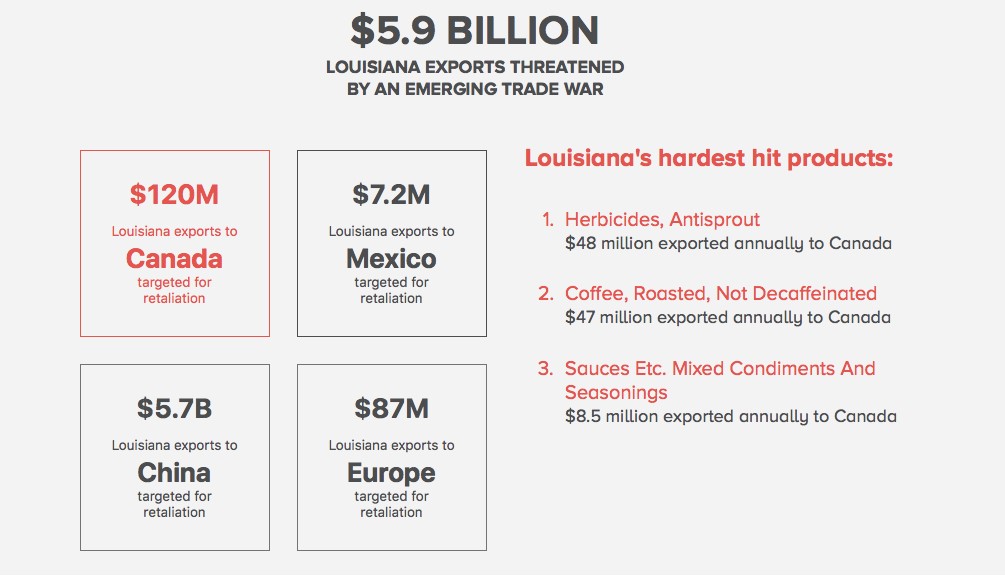As the trade war has officially kicked off, Citi analysts warn Trump that tariffs will bite hardest in those states that overwhelmingly voted for him hardest, while the Chamber of Commerce—the world’s largest business association—goes on the campaign warpath.
Instead of trying to paint a doom-and-gloom big picture, which is generally too broad to sway American opinions, the Chamber of Commerce is starting where it hurts most—individual states.
And their impact hitlist is hard-hitting, with an interactive map that shows you exactly what’s at stake.
The state of Washington, for instance, stands to lose as much as $6.2 billion in this trade war.

(Click to enlarge)
Louisiana stands to lose $5.9 billion:

(Click to enlarge)
While California stands to lose $5.6 billion.

(Click to enlarge)
After that, the next 10 trade-war losers line up like this:
• Texas, $3.9 billion
• Illinois, $3.8 billion.
• Alabama, $3.6 billion
• Ohio, $3.3 billion
• South Carolina, $3 billion
• Michigan, $2.3 billion
• New York, $1.6 billion
• Kentucky, $1.5 billion.
• Tennessee, $1.4 billion
• North Carolina, $1.1 billion
It’s a recipe for disaster, according to the Chamber of Commerce, whose new mantra is “Trade Works. Tariffs Don’t.” Related: AT&T Poised To Profit Big In The Digital Ad Space
“Tariffs imposed by the United States are nothing more than a tax increase on American consumers and businesses–including manufacturers, farmers, and technology companies–who will all pay more for commonly used products and materials,” according to the Chamber.
“Retaliatory tariffs imposed by other countries on U.S. exports will make American-made goods more expensive, resulting in lost sales and ultimately lost jobs here at home.”
Citi analysts have a slightly different take on the matter, but no less alarming.
Speaking to CNBC, Citi’s North America economist, Dana Peterson, said those states that voted “overwhelmingly” in favor of Trump in 2016 will lost the most because they have “jobs and output significantly affected by tariffs”.
Dividing states into ‘red’ (Trump voters) and ‘blue’, Peterson said: “80 percent of ‘red’ states produce goods subject to retaliatory tariffs totaling 10 percent or more of GDP, compared to 10 percent of ‘blue’ states.”
In blue states, there are some 2.5 million jobs linked to foreign trade that will be affected by the tariff tit-for-tat, while in red states there are 3.9 million such jobs.
As of last week, according to the Chamber of Commerce, approximately $75 billion worth of U.S. exports will be subject to retaliatory tariffs, raising prices for consumers and “making it harder for families to afford everyday products like toilet paper, condiments, coffee and ballpoint pens, which have been targeted for retaliation”.
And now it’s a political tool of convenience for everyone on the wrong end of tariffs, with China—for one—hoping that toilet paper, if not jobs, will weigh heavily on upcoming elections.
Noting that Trump’s trade actions are “backfiring”, Peterson said that “economies exacting retaliatory measures are openly targeting goods produced in ‘red’ states, and sectors the President champions, as well as states represented by key players in Congress, including majority and minority leaders of the House and Senate. Hence, the intensity and duration of the trade disputes may be calibrated by voter sentiment ahead of the midterm elections.”
Related: How Will Gold Respond To Escalating Tariff Wars?
The problem for the retaliators here is that the pain isn’t going to hit hard enough and fast enough to upend the midterm elections, even if they chip away at support for Trump in the long run.
And then there is the growing trend of Trump voters actually increasing support for him when the drama barometer is at its highest reading, negative or positive. Indeed, some feel this is a miscalculation, particularly on the part of China, which fails to account for the fact that this U.S. presidency is like other.
By Charles Benavidez for Safehaven.com
More Top Reads From Safehaven.com:
















